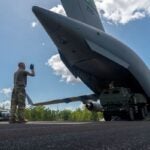
As the U.S. Air Force Special Operations Command (AFSOC) ponders a follow-on to the Bell [TXT]-Boeing [BA] CV-22 tiltrotor and materiel to support future close air support/precision strike and intelligence, surveillance, and reconnaissance missions, the AFSOC commander suggested on Nov. 23 that relatively stable or declining DoD budgets will mean thinking of innovative uses of existing equipment. "These are all questions that we're going to have to struggle with, and we're going to have to view it through the lens…














